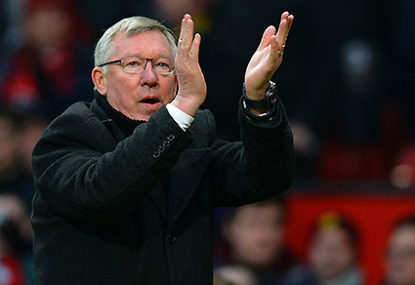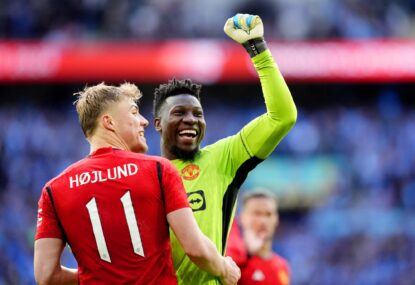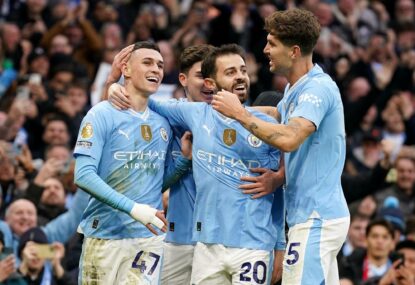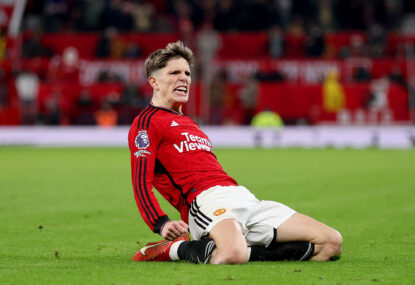Let’s ignore the conjecture about whether David Moyes is capable of filling Sir Alex Ferguson’s enormous shoes for a moment. Moyes’ own sizeable footwear are in need of some attention as well.
The 50-year-old Glaswegian is living proof that success – and managerial skill – cannot be measured in titles alone.
After all, the closest he came to winning a competition with the Toffees was a 2-1 loss to Chelsea in the 2009 FA Cup final.
However, there’s no denying Moyes has done an incredible job in his 11 years at Everton.
He arrived at Merseyside in March 2002 at a club with a proud history but a diminished stature. He departs having firmly secured its reputation as one of the Premiership’s great overachievers.
In the decade prior to Moyes’ tenure, Everton – one of the most successful clubs in England with nine league championships and five FA Cup wins – finished in the top 10 only once.
The club had followed its best-ever period in the 1980s with a prolonged phase of relegation scrapes and management volatility.
Since he commenced, however, the club has finished outside the top 10 in the league only twice and within the top eight every season since 2007/08.
Everton qualified for the UEFA Cup three times from 2006-2009 and the qualifying playoffs of the UEFA Champions League in 2005.
Furthermore, the club is all but guaranteed to finish above local rivals Liverpool for the second consecutive season.
The fans now believe the team can not only compete, but excel against the bigger clubs.
Ambitious as it may be, the club has rightly aimed for a place in the Champions League. For much of this season, it was a credible contender for a berth.
Moyes has been the architect of this belief – and it’s well documented that he has built it with the scarcest of resources.
According to website TransferLeague.co.uk, the club’s average net transfer spend since 2003/04 has been about £863,000 per season.
In that same period, United’s net spend is more than £12 million per season, an amount that will surely warm Moyes’ heart.
Meanwhile, Chelsea and Manchester City’s average net spend was £52.5 million and £41.7 million per season, respectively.
Current Championship clubs Wolverhampton, Middlesbrough, Birmingham and Hull City have all had higher average net spends in the seasons since 2003/04.
It cost Liverpool £35.4 million in 2011/12 and £40.8 million this season to finish below Everton on the league table.
Everton actually made money through player sales during the same period.
In fact, you have to go back to 2008/09 to find an instance where the club spent more on incoming players than it made on outgoing players.
The results have come through recognising and working within the club’s financial limitations, and grabbing a bargain when it comes.
For example, Nikica Jelavic was brought into the club for £6 million in January 2012. Since then, the Croatia striker has scored 16 goals in 48 league games. That equates to £375,000 per goal.
Admittedly, his form and confidence have waned this season, but his nine goals in 13 games last season were key to the club’s strong finish to reach seventh place.
In contrast, Andy Carroll cost Liverpool £35 million in 2010/11. He scored six goals in 44 league games (£5.8 million per goal) and was loaned out to West Ham for the duration of this season.
There are a host of other players who have excelled at the club, despite their low transfer value.
Steven Pienaar cost only £2 million for his first stint at the club and £4.5 million for his second. Mikel Arteta arrived from Rangers for only £2 million and was sold to Arsenal for £10 million, where he is now a key player.
Joleon Lescott was acrimoniously sold to Manchester City in 2009 for £22 million. He originally cost £5 million. Leighton Baines, one of England’s best left fullbacks, cost only £6 million.
The list goes on: our own Tim Cahill cost £1.5 million; England international centre half Phil Jagielka arrived for £4 million; while key midfielder Darron Gibson was brought in for £2 million.
So while the challenge of taking over a club with expectations as high as United’s may be daunting, matching these results at Everton cannot be underestimated.
Ferguson himself described his fellow Scot’s efforts as “miraculous”.
The fans now rightly expect the team to overachieve, season in, season out.
The new manager, whether it is Roberto Martinez, Michael Laudrup, Neil Lennon or even Phil Neville, will have to meet these expectations.
Reports suggest Marouane Fellaini and Leighton Baines, both so pivotal to the successes of recent seasons, are likely to leave next season – Baines may even follow Moyes to United.
Their sales will give the new boss some funds to build his own team – Fellaini reportedly has a £24 million buy-out clause in his contract – but the replacements will have to be prudent purchases.
There are other deficiencies that must be addressed with that cash as well.
So in order to rebuild a squad that is capable of keeping pace with the big teams, the new manager will have to match, or at least approach, Moyes in the areas in which he most excelled: financial acumen and judging a player’s true value.
It’s not going to be easy.
So, tell me, whose shoes look big now?




































































































